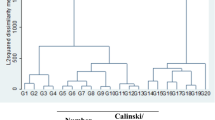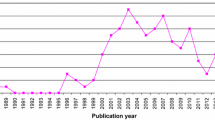Abstract
In this article we analyse whether university-industry relations (UIR) are penalising research activity and inhibiting university researchers’ scientific productivity and, if so, to what extent. The analysis is based on a case study of two Spanish universities. We find that UIR exercise a positive effect on university scientific productivity only when they are based on the development of R&D contracts, and when the funds obtained through these activities do not exceed 15% of the researcher’s total budget. We also find that researchers who combine research and UIR activities obtain higher funding from competitive public sources than that engage only in research. In addition, their average scientific productivity is higher and they achieve higher status within their institutions than those members of faculty who concentrate only on research.
Similar content being viewed by others
References
Arocena, R., Sutz, J. (2005), Latin American Universities: From an original revolution to an uncertain transition, Higher Education, 50: 573–592.
Azagra, J. (2004). La Contribución de las Universidades a la Innovación, PhD dissertation, University of Valencia.
Azagra, J., Archontakis, F., Gutierrez, A., Fernández, I. (2006), Faculty support for the objectives of university-industry relations versus degree of R&D cooperation: The importance of regional absorptive capacity, Research Policy, 35: 37–55.
Blumenthal, D., Campbell, E., Anderson, M., Causino, N., Seashore-Louis, K. (1996), Participation of life-science faculty in research relationships with industry, New England Journal of Medicine, 335: 1734–1739.
Bonaccorsi, A., Daraio, C. (2003), Age effects in scientific productivity — The case of the Italian National Research Council (CNR), Scientometrics, 58: 49–90.
Bonaccorsi, A., Daraio, C., Simar, L. (2006), Advanced indicators of productivity of universities. An application of robust nonparametric methods to Italian data, Scientometrics, 66: 389–410.
Carayol, N., Matt, M. (2006), Individual and collective determinants of academic scientists productivity, Information Economics and Policy, 18: 55–72.
Clark, B. R. (1996), Creando universidades emprendedoras en Europa, Revista Valenciana d’Estudis Autonòmics, 21: 373–392.
Dasgupta, P., David, P. (1994), Towards a new economics of science, Research Policy, 23(5): 487–521.
Dickinson, J. (1971), No Parametric Statistical Inference, Dekker, New York.
Enros, P. C., Farley, M. (1986), University Offices for Technology: Towards the Service University, Ottawa: Science Council of Canada.
Etzkowitz, H. (1990), The Second Academic Revolution: The Role of the Research University in Economic Development. In: S. Cozzens, P. Healey, A. Rip., J. Ziman (Eds), The Research System in Transition. Boston: Kluwer Academic Publishers, pp. 109–124.
Etzkowitz, H. (2003), Innovation in innovation: The triple helix of university-industry-government relations, Social Science Information, 42(3): 293–337.
Florida, R., Cohen, W.M. (1999), Engine or infrastructure? The university role in economic development. In: Branscomb, L.M., Kodama, F., Florida, R. (Eds), Industrializing Knowledge. University-Industry Linkages in Japan and the United States. MIT Press, Cambridge MA/London, pp. 589–610.
Fundación Cyd, (2005), Informe CYD 2005, La contribución de las universidades españolas al desarrollo”, Barcelona.
Garcia-Aracil, A., Gracia, A. G., Perez-Marin, M. (2006), Analysis of the evaluation process of the research performance: An empirical case, Scientometrics, 67: 213–230.
Geuna, A. (1999), The Economics of Knowledge Production. Funding and the Structure of University Research, Edward Elgar, Cheltenham, UK.
Gulbrandsen, M., Smeby, J. (2005), Industry funding and university professors’ research performance, Research Policy, 34: 932–950.
Hernández-Armenteros, J. (2004), La Universidad Española en Cifras. Información académica, productiva y financiera de las universidades públicas españolas, Año 2002, Indicadores universitarios curso académico 2002/2003, Madrid: Conferencia de Rectores de las Universidades Españolas.
Knorr, K. D., Mittermeier, R., Aichholzer, G., Waller, G. (1979), Individual publication productivity as a social position effect in academic and industrial research units. In: Andrews, F. (Ed.), The Effectiveness of Research Groups in Six Countries. Cambridge University Press, pp. 55–94.
Landry, R., Traore, N., Godin, B. (1996), An econometric analysis of the effect of collaboration on academic research productivity, Higher Education, 32: 283–301.
Lee, Y. S. (1996), Technology transfer and the research university: a search for the boundaries of university-industry collaboration, Research Policy, 25: 843–886.
Lehman, H. C. (1958), The chemist most creative years, Science, 127: 1213–1222.
Lehman, H. C. (1960), The decrement in scientific productivity, American Psychologist, 15: 128–134.
Leydesdorff, L., Meyer, M. (2003), The triple helix of university-industry-government relations, Scientometrics, 58: 191–203.
Levin, S.G., Stephan, P.E., (1991), Research productivity over the life cycle: Evidence for academic scientists, American Economic Review 81: 114–132.
Martin, B., Etzkowitz, H. (2000), The origin and evolution of the university species, VEST, 13: 3–4.
Mccullagh, P. (1980), Regression models for ordinal data, Journal of the Royal Society, 42: 109–142.
Mcleay, S., Trigueiros, D. (1998), Proportionate Growth and the Theoretical Foundations of Financial Ratios, Congress of the European Accounting Association, Antwerp, Belgian.
Molas-Gallart, J., Salter, A., Patel, P., Scott, A., Duran, X. (2002), Measuring Third Stream Activities. Final report to the Russell Group of Universities, SPRU, University of Sussex.
Nowotny, H., Scott, P., Gibbons, M. (2001), Re-Thinking Science: Knowledge and the Public in an Age of Uncertainty, MA: Polity Press, Cambridge.
Peterson, B., Harrell, F. E. (1990), Partial proportional odds models for ordinal response variables, Applied Statistics, 39: 205–217.
Rosenberg, N., Nelson, R. R. (1994), American universities and technical advance in industry, Research Policy, 19: 165–174.
Sánchez, J.J. (1999), Manual de Análisis Estadístico de los Datos, Alianza editorial.
Smilor, R. W., Dietrich, G., Gibson, D. V. (1993), La Universidad Empresarial: Función de la educación superior en los Estados Unidos en materia de comercialización de la tecnología y el desarrollo económico, Revista Internacional de Ciencias Sociales 135: 3–14.
Tuunainen, J. (2005), Hybrid practices? Contributions to the debate on the mutation of science and university, Higher Education, 50: 275–298.
Zuckerman, H.A., Merton, R.K., (1972), Age, aging, and age structure in science. In: Riley, M. R., Johnson, M., Foner, A. (Eds), A Sociology of Age Stratification: Aging and Society, vol. 3, Russel Sage foundation, New York, Reprinted In: Storer, N. W. (Ed.), 1973. The Sociology of Science: Collected Papers of R. K. Merton, Chicago University, Chicago Press, pp. 497–559.
Author information
Authors and Affiliations
Corresponding author
Rights and permissions
About this article
Cite this article
Manjarrés-Henríquez, L., Gutiérrez-Gracia, A. & Vega-Jurado, J. Coexistence of university-industry relations and academic research: Barrier to or incentive for scientific productivity. Scientometrics 76, 561–576 (2008). https://doi.org/10.1007/s11192-007-1877-7
Received:
Published:
Issue Date:
DOI: https://doi.org/10.1007/s11192-007-1877-7




